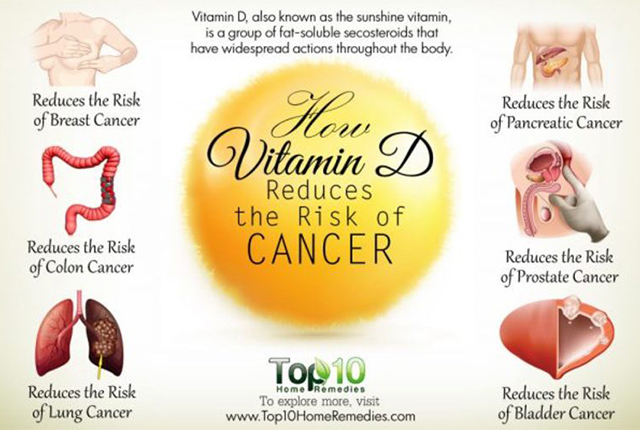How Vitamin D reduces the risk of cancer

Vitamin D, also known as the sunshine vitamin, is a group of fat-soluble secosteroids that have widespread actions throughout the body. This vitamin is responsible for increasing intestinal absorption of calcium, iron, magnesium, phosphate and zinc. It boosts the immune system, reduces inflammation, regulates numerous cellular pathways, promotes cell growth, supports neuromuscular functions and more.Several recent studies show that vitamin D plays a crucial role in preventing and treating various cancers.
In a 2016 study published in PLOS ONE, researchers reported that higher levels of vitamin D — specifically serum 25-hydroxyvitamin D — are associated with a correspondingly reduced risk of cancer.
Maintaining the right level of vitamin D can help prevent at least 16 different types of cancer, including breast, colon, lung, pancreatic, ovarian, prostate and bladder cancers.
Here’s a look at the role of vitamin D and its impact on different types of cancer.
1. Vitamin D and breast cancer
Breast cancer is one of the most common types of cancer diagnosed in women worldwide.
A 2006 study published in Cancer Epidemiology, Biomarkers & Prevention reports the positive connection between vitamin D and breast cancer.
The study highlighted the anticarcinogenic effect of vitamin D due to its participation in regulating cell proliferation, differentiation and apoptosis in normal and malignant breast cells.
Plus, a prospective study published in Cancer Causes and Control in 2013 notes that low serum vitamin D levels in the months preceding diagnosis may predict a high risk of premenopausal breast cancer. In fact, the risk is three times higher in women who have extremely low serum vitamin D levels.
Another study published in Anticancer Research in 2014 suggests that patients suffering from breast cancer with high levels of the vitamin in their blood are more likely to survive the disease than patients with low levels.

Egg yolks are a great source of Vitamin D but you must limit intake because of high cholestrol content
This study included more than 4,000 patients with breast cancer and was conducted between 1966 and 2010. All patients were followed for an average of nine years.
This study says that 25-hydroxyvitamin D, a metabolite produced by the body from the ingestion of vitamin D, increases communication between cells by switching on a protein that blocks aggressive cell division.
This prevents tumour growth and keeps it from expanding its blood supply. This is the reason for better survival in patients whose vitamin D blood levels are high.
2. Vitamin D and colon cancer
Colon cancer is also referred to as colorectal or bowel cancer.
An adequate amount of vitamin D in the body can help prevent and reduce the risk of this cancer. The sunshine vitamin helps regulate cell growth, fight inflammation and prevent cancer cells from spreading.
In fact, it has been found that colon cancer diagnosis and death rates are lowest in states with the highest mean solar radiation.
A 2004 study published in Cancer Epidemiology, Biomarkers & Prevention analysed several studies and came to the conclusion that 1,25-dihydroxyvitamin D and its precursor, 25-hydroxyvitamin D, may aid in the prevention of colorectal cancer in older women.
Another 2011 study published in Cancer Prevention Research says that vitamin D may decrease colon cancer risk by improving differentiation and apoptosis and decreasing proliferation, invasiveness, metastatic potential and angiogenesis.
The study notes that it is even more significantly associated with reduced rectal cancer risk.
In a 2014 study published in Gut, researchers studied a group of immune system cells called T lymphocytes, or T cells, that can target tumour cells and limit their growth.
They found that a high plasma 25-hydroxyvitamin D level is associated with a lower risk of colorectal cancer with intense immune reaction, supporting a role of vitamin D in cancer immune prevention through tumour–host interaction.
Moreover, high vitamin D levels can improve response to chemotherapy and targeted anticancer drugs in patients with advanced colon cancer.
3. Vitamin D and lung cancer
Lung cancer is the second most diagnosed cancer in the US. Both men and women are affected equally and it causes about 27 percent of all cancer deaths, according to the American Cancer Society
Regular sun exposure to help the body produce vitamin D can help lower the rate of lung cancer and resulting deaths. In fact, people living at higher elevations are less likely to suffer from this type of cancer.
Vitamin D helps block the growth of cancer tumours, thanks to a form of vitamin D called calcitriol that helps limit blood supply to a tumour, thus preventing it from spreading.
A 2008 study published in Cancer Epidemiology, Biomarkers & Prevention analysed various studies and suggested that although there is no overall association between the 25-hydroxyvitamin D level and lung cancer risk, higher circulating levels of vitamin D in the body may help lower the risk.
Another study published in Anticancer Research in 2012 reports that vitamin D is converted to its active form locally in the lung, which in turn plays an important role in lung health.
In a recent 2015 study published in Cellular Physiology and Biochemistry, 453 research abstracts were studied and 12 papers published between 2006 and 2014 were considered for inclusion in the meta-analysis.
All studies provided adjusted risk estimates of lung cancer according to the levels of vitamin D.
4. Vitamin D and pancreatic cancer
Pancreatic cancer, the fourth most common cause of death from cancer, resulted in 330 000 deaths globally in 2012.
People living in warm, sunny climates may have a higher risk of non-melanoma skin cancer, but a significantly lower risk of pancreatic cancer.
There is a potential role for vitamin D in the pathogenesis and prevention of pancreatic cancer.
A 2006 study published in Cancer Epidemiology, Biomarkers & Prevention reports that a higher 25-hydroxyvitamin D score was associated with a lower risk of pancreatic cancer.
A 2010 study published in the British Journal of Cancer analysed two prospective cohort studies for evaluating vitamin D status in relation to pancreatic cancer risk.
A later 2013 study published in the Journal of Translational Medicine reports that vitamin D insufficiency and deficiency were prevalent in people suffering from pancreatic adenocarcinoma.
In fact, vitamin D level appears to be prognostic for patients with advanced pancreatic adenocarcinoma.
5. Vitamin D and prostate cancer
Prostate cancer is very common, especially in older men. According to the American Cancer Society, it is the second most common cancer in men, after skin cancer.
It can often be treated successfully with vitamin D. In fact, more than 2 million men in the US are survivors of prostate cancer.
A 2009 study published in the British Journal of Cancer found that men with prostate cancer who were on hormonal treatment showed better improvement in treatment when supplemented with 25-hydroxyvitamin D.
Another study published in the Journal of the National Cancer Institute in 2012 found that higher 25-hydroxyvitamin D levels were associated with a 57 percent reduction in the risk of prostate cancer in men.
A 2013 study published in the Journal of Steroid Biochemistry and Molecular Biology suggests that supplementation with vitamin D3 at 4 000 IUs per day may benefit patients with early stage cancer.
In a recent 2015 study published in American Chemical Society, researchers concluded that taking vitamin D supplements could slow or even reverse the progression of less aggressive, or low-grade, prostate tumours without the need for surgery or radiation.
6. Vitamin D and bladder cancer
According to the American Cancer Society, bladder cancer is the fourth most common cancer in men, but it is less common in women. It typically affects older adults, though it can occur at any age.
A 2001 study published in the Journal of Urology analysed the effects of vitamin D (calcitriol) on transitional cell carcinoma of the bladder in vitro and in vivo.
Results showed that calcitriol inhibits proliferation and induces apoptosis in human bladder tumour cells in vitro and may have therapeutic potential in bladder cancer.
A few years later, in a study published in the Journal of the National Cancer Institute in 2012, it was found that high levels of vitamin D are effective in protecting against bladder cancer.
The research results suggest that an increase in the dietary or supplementary intake of this vitamin, or via a controlled increase in sun exposure, may be beneficial in terms of prevention and treatment of bladder cancer.
One year later, researchers found that both the chances of survival and longevity improved with enhanced vitamin D status and monitoring, according to a study published in the Southern Medical Journal in 2013.
A recent 2015 meta-analysis published in Tumour Biology suggests an obvious protective effect of vitamin D against bladder cancer. Individuals with higher serum 25-hydroxyvitamin D levels suffer from less risk of subsequent bladder cancer. — top10homeremedies.com
11 ways to get your daily Vitamin D
Getting more Vitamin D
Vitamin D is essential for bone health. Recent research suggests it may have other benefits, too, such as protecting against colds and fighting depression.
The good news is that most people get enough Vitamin D, according to the Institute of Medicine (IOM).
However, if you don’t spend enough time in the sun or if your body has trouble absorbing the vitamin, you may not get enough. Here are 12 ways to ensure adequate intake.
Sunlight
Sunlight spurs the body to make Vitamin D. But because of the skin-cancer risk, there isn’t an official recommendation to catch some rays. However, a small amount of sun exposure without sunscreen can do the trick.
“If you’re going to get it from the sun, about 20 to 25 minutes of exposure is helpful,” says Stephen Honig, MD, director of the Osteoporosis Centre at the Hospital for Joint Diseases, in New York City.
The sun is less likely to provide your daily needs at higher latitudes, in the winter, or if you’re older or dark skinned (skin pigment blocks light and the process is less efficient with age). And FYI: Light through a window won’t work.
Fatty fish
Fatty fish can be a good source of Vitamin D. Common options include salmon, trout, mackerel, tuna, and eel.
A 3-ounce sockeye salmon fillet contains about 450 international units (IUs) of Vitamin D — a good portion of the 600 IUs that is the Institute of Medicine’s recommended dietary allowance (800 IUs if you’re over 70).
And you get a bonus — heart-healthy omega-3 fatty acids!
Canned tuna and sardines
Fresh fish aren’t the only way to boost your Vitamin D intake; you can get Vitamin D from a can, too.
Canned tuna fish and canned sardines both contain Vitamin D, and are usually less expensive than fresh fish.
Plus, a longer shelf life makes the canned products easy to stock up on and use at your leisure. Canned light tuna has the most Vitamin D — about 150 IUs per 4 ounces — while canned albacore tuna has about 50 IUs per 4 ounces, and canned sardines have a little more than 40 IUs per two sardines.
Certain mushrooms
Just like humans, mushrooms have the capacity to produce Vitamin D when exposed to ultraviolet light.
So mushrooms are good sources of Vitamin D. But unfortunately mushrooms grown in the dark do not qualify. So commercially produced mushrooms grown in dark rooms will not do anything for your Vitamin D balance.
Fortified milk
Some types of milk are fortified. Check the information. But ice cream and cheese are not fortified so there is no substitute for milk.
In general, an 8-ounce glass of milk contains at least 100 IUs of Vitamin D, and a 6-ounce serving of yogurt contains 80 IUs, but the amount can be higher (or lower) depending on how much is added.
Some soy and rice milks are fortified with about the same amount, but check the label since not all contain vitamin D.
Some types of orange juice
Not a dairy fan? No problem. You can get vitamin D from fortified orange juice.
One 8-ounce glass of fortified juice usually has around 100 IUs of Vitamin D, but the amount varies from brand to brand. Not all brands are fortified, so check the label.
Supplements
Vitamin D supplements can help you get your proper daily dose, and as Dr Honig points out, you don’t run into the issue of skin cancer as you might with UV rays.
“And it’s not like calcium,” he says. “You don’t have to split up your Vitamin D dose; you can take it all at one time.”
Too much Vitamin D can be toxic, however. The IOM sets the upper limit at 4 000 IUs for people aged 9 and older. That includes all sources — food, sun, and supplements.
Talk to your doctor before choosing a dosage.
Egg yolks
Eggs are a convenient way to get Vitamin D. They’re popular in many breakfast, lunch, dinner, and dessert recipes.
Since the Vitamin D in an egg comes from its yolk, it’s important to use the whole egg — not just the whites. One yolk will give you about 40 IUs, but don’t try to get your daily Vitamin D just from eggs.
One egg contains about 200 milligrams of cholesterol, and the American Heart Association recommends consuming no more than 300 milligrams a day for heart health.
Fortified cereal
If you’re a Vitamin D seeker looking for a crunch, look no further than fortified cereals. Choose a low-calorie fortified cereal to get part of your daily fill of Vitamin D. You can pair it with fortified milk and a glass of fortified OJ too.
Beef liver
A 3,5-ounce serving of cooked beef liver contains about 50 IUs of Vitamin D — and several other nutrients. You’ll also be getting Vitamin A, iron, and protein.
However, beef liver is also high in cholesterol, so you might want to choose an oily fish instead.
Cod liver oil
While its name might suggest a less-than-savory flavour, cod liver oil is often flavored with mint or citrus, or comes in capsule form.
One tablespoon contains about 1 300 IUs of Vitamin D, which is more than twice the recommended dietary allowance of 600 IUs per day.
That amount doesn’t exceed the maximum upper-level intake of 4 000 IUs for people over 8 years old, but it exceeds the daily maximum for infants (1 000 IUs). — health.com











Comments